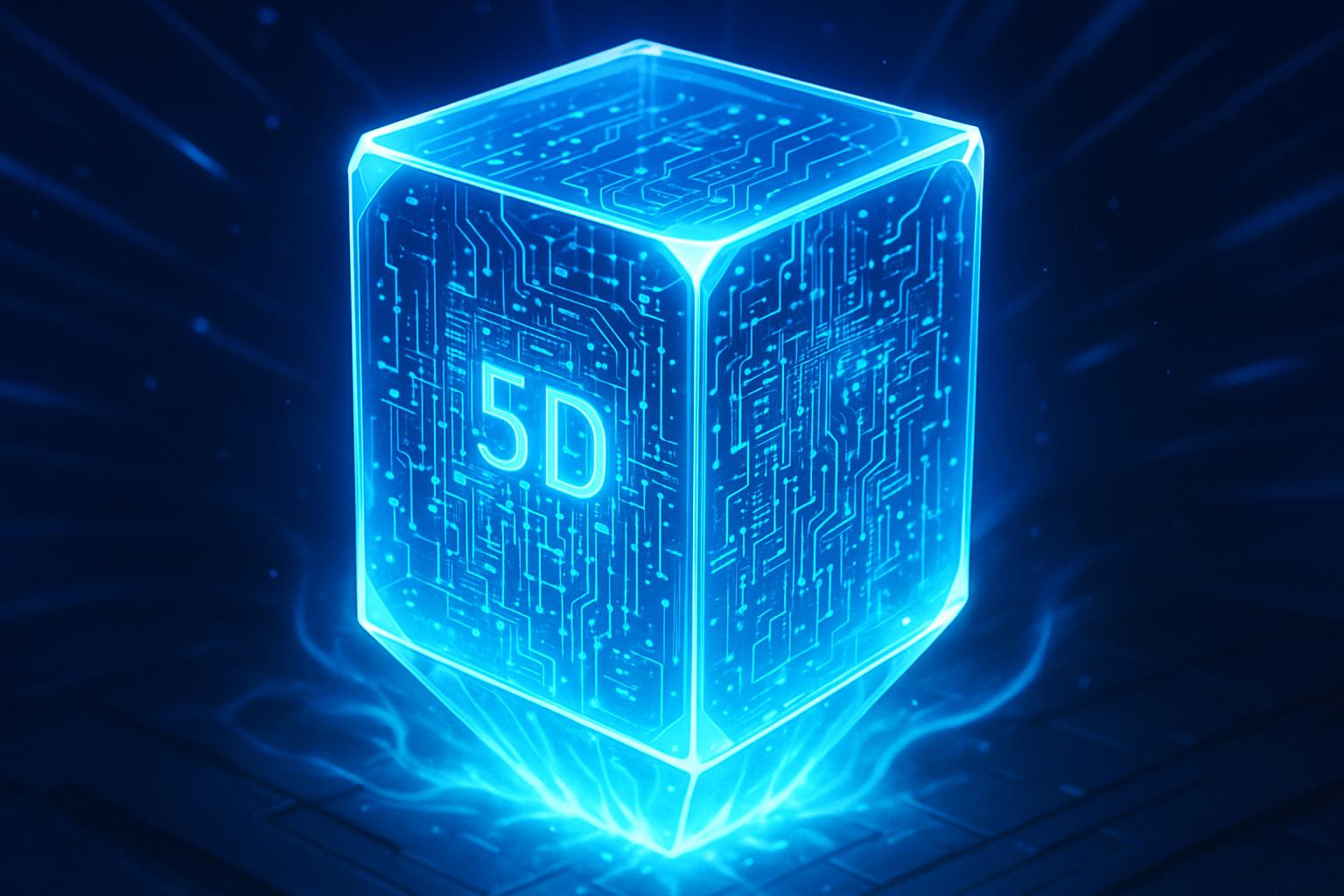Sphotonix’s revolutionary 5D Memory Crystals feature prominently in the latest Mission Impossible film, highlighting a futuristic storage medium capable of holding 360TB on a durable glass disc, signalling a major leap in long-term data archiving amid surging global storage demands.
In an intriguing blend of technology and entertainment, Sphotonix’s groundbreaking 5D optical storage media has made a significant appearance in the latest film of the “Mission Impossible” franchise, titled “The Final Reckoning.” This unexpected feature goes beyond a mere cameo; the storage medium plays a pivotal role in the plot, highlighting its futuristic capabilities in a context that resonates with audiences. As storage demands surge—exacerbated by the rise of data-hungry technologies like artificial intelligence—the importance of such innovations becomes ever more apparent.
Sphotonix’s 5D Memory Crystals, which can store up to an astonishing 360TB on a 5-inch glass platter, represent a significant leap in data storage technology. Using a proprietary laser-based nano etching technology known as FemtoEtch, this medium not only eclipses traditional storage solutions like solid-state drives and hard disk drives but also positions itself as a durable option for critical long-term data archiving. The crystals’ resilience is underscored by successful demonstrations, including the backup of the complete human genome earlier this year, cementing their reputation in the realm of data preservation.
The concept of 5D optical storage transcends conventional understandings of data retention. Unlike earlier media, Sphotonix’s approach utilises femtosecond laser writing to create complex nanostructures within fused quartz glass, resulting in storage capacities and thermal stability that outstrip legacy solutions. For instance, these crystals boast thermal endurance up to 1,000°C and a virtually unlimited lifetime, making them an ideal candidate for the archiving of sensitive and invaluable digital information.
Moreover, as noted by experts in the field, the landscape of data storage is evolving rapidly, driven by an insatiable demand for increased capacity. The enterprise information archiving market alone is projected to surpass $17 billion by 2031. Companies like Microsoft, with its Silica storage initiative, and other competitors employing ceramic and DNA-based methods are also vying to capture market share in this expanding field.
Yet, the road ahead is fraught with challenges. Historical attempts to innovate, such as Sony’s 5.5TB optical disc, have met with limited success, underlining the competitive nature of this sector. As data centres are anticipated to consume over 1,000TWh of power by 2028—a year when global data generation is expected to reach nearly 400 Zettabytes—the urgency for efficient, high-capacity solutions has never been greater.
Notably, Sphotonix’s origin story is rooted in over three decades of research spearheaded by its Chief Science Officer, Professor Kazansky, at the University of Southampton. This academic foundation lends additional credibility to the innovation, signalling robust potential for future advancements.
As Sphotonix continues to carve out its niche in the data storage ecosystem, its cinematic debut not only raises awareness of its technological prowess but also positions it as a serious contender in the future of high-capacity storage. While the film may entertain, its underlying message about the importance of data preservation and innovation in our rapidly digitising world holds profound implications for how we think about and manage information for generations to come.
Reference Map:
- Paragraph 1 – [1], [4]
- Paragraph 2 – [1], [2], [6]
- Paragraph 3 – [3], [5], [7]
- Paragraph 4 – [1], [2], [3], [6]
Source: Noah Wire Services
- https://www.techradar.com/pro/mission-impossible-the-final-reckoning-gets-surprise-guest-appearance-a-revolutionary-360tb-silica-storage-media – Please view link – unable to able to access data
- https://www.sphotonix.com/memory-crystal/ – SPhotonix offers 5D Memory Crystals, a revolutionary data storage solution capable of preserving up to 360TB of data on a 5-inch glass platter. These crystals utilise ultrafast laser nanostructuring to create nanoscale structures within the glass, ensuring exceptional durability and longevity. Designed to withstand extreme temperatures and environmental conditions, they provide a secure and scalable option for both personal and enterprise data archiving needs. SPhotonix’s technology is ideal for long-term storage of critical data, historical records, and personal memories, offering a future-proof solution for data preservation.
- https://www.sphotonix.com/about-us/ – SPhotonix is a pioneering company specialising in advanced data storage and optoelectronic technologies. With decades of research in femtosecond laser writing and nanostructuring, they are bringing innovative solutions to the market that enable new possibilities in data storage, optics, and imaging. Their mission is to deliver groundbreaking innovation in data storage and ultrafast laser nanostructuring, safeguarding the digital future and pioneering new technologies for a wide range of applications. SPhotonix is committed to revolutionising data storage with cutting-edge nanostructuring technologies, utilising ultrafast lasers to unlock unprecedented capacity, durability, and speed.
- https://www.5dmemorycrystal.com/ – The ‘Superman memory crystal’ is a nanostructured glass developed by researchers at the University of Southampton, capable of storing up to 360 terabytes of data per disc. This technology, known as 5D optical data storage, records data using femtosecond laser writing to create nanoscale structures within fused quartz. The storage method offers unprecedented parameters, including thermal stability up to 1000°C and a practically unlimited lifetime, making it ideal for long-term data preservation. The ‘Superman memory crystal’ has been compared to the memory crystals used in the Superman films, highlighting its potential for storing vast amounts of data for over a million years.
- https://www.nature.com/articles/nature08053 – A study published in Nature describes a five-dimensional optical recording technique that integrates two optical dimensions—wavelength and polarization of light—with the three spatial dimensions to create true five-dimensional recording within one volume. This method has the potential to increase storage capacities by several orders of magnitude, with a theoretical capacity of 1.6 terabytes for a DVD-sized disk. The system employs surface plasmon resonance-mediated photothermal reshaping of a substrate of gold nanorods immersed in a polymer layer, enabling high-density data storage with enhanced security and multiplexing capabilities.
- https://www.advancedsciencenews.com/nanostructuring-quartz-glass-leads-to-5d-optical-memory/ – Scientists at the University of Southampton have demonstrated the recording and retrieval processes of five-dimensional digital data by femtosecond laser writing in nanostructured glass. This 5D optical memory allows unprecedented parameters, including 360 terabytes per disc data capacity, thermal stability up to 1000°C, and a practically unlimited lifetime. The data is recorded via self-assembled nanostructures created in fused quartz, enabling storage of vast quantities of data for over a million years. This technology offers a durable and long-term solution for data preservation, surpassing traditional storage methods in capacity and longevity.
- https://www.sphotonix.com/data-storage-innovation/ – SPhotonix is revolutionising the future of mainstream data storage through cutting-edge research and the development of proprietary technologies. Their strategic focus is on creating scalable, high-capacity solutions that meet the growing global demand for durable, energy-efficient storage systems. By leveraging their groundbreaking 5D Memory Crystal technology and a robust portfolio of intellectual property, SPhotonix is positioned to enable the next generation of data storage systems. Their innovations in ultrafast laser nanostructuring are unlocking unprecedented capacity, durability, and speed, paving the way for next-generation data storage solutions.













